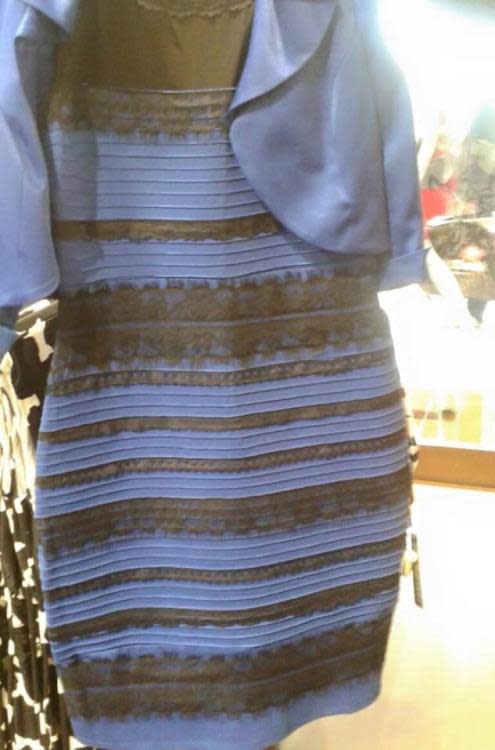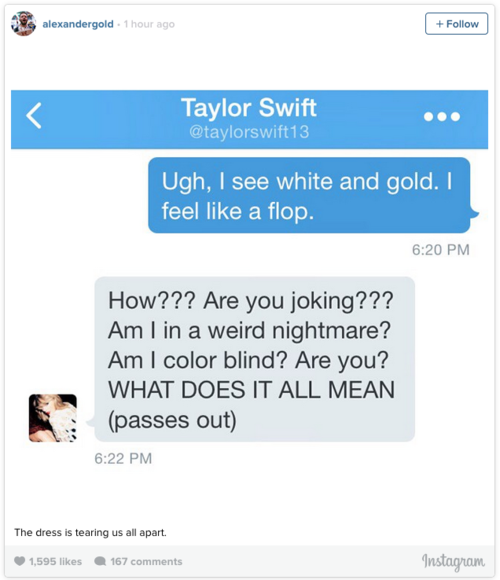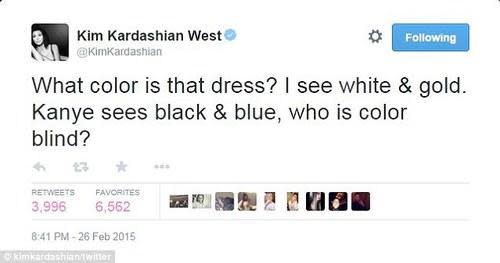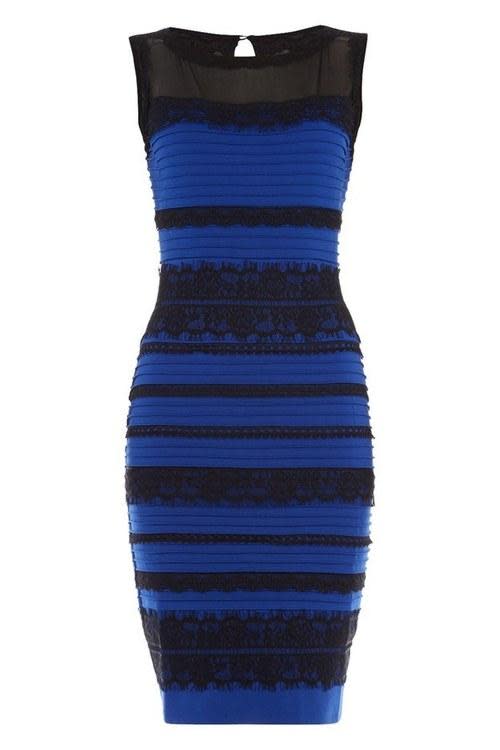Is This Dress Blue And Black Or White And Gold? Here's What The Experts Say

There’s a debate dividing the Internet that’s splitting apart offices, marriages and friendships alike. It is…
What color is this dress?

(Photo: Swiked/Tumblr)
Ladies and gentlemen, welcome to #DressGate. Some see the dress as white and gold. Others see blue and black.
And the two sides cannot agree.
The debate began on Tumblr Thursday when a user named Swiked posted the image of the dress, above, along with a plea: “Guys please help me — is this dress white and gold, or blue and black? Me and my friends can’t agree and we are freaking the [expletive deleted] out.”
The image immediately caused controversy: “My class just had a debate over this. Half sees black and blue, the other half sees gold and white. Someone please explain this…”
"If that’s not gold my entire life has been a lie," replied Swiked.
The image spread like wildfire and, from Facebook to Twitter to media sites, everyone is mystified. A Buzzfeed survey says 74 percent say white and gold, while the other 26 percent saw blue and black.
Taylor Swift freaked out on Instagram:

Even Kim and Kanye are divided:

Then, celebrities began mud slinging about the color of The Dress:

This writer saw gold and white, until I glimpsed this image, below, which, some think is the actual dress in question, from a UK retailer. The dress, on the website, is blue and black. And once I saw this image, the original image changed to blue and black and I can no longer see the dress as white and gold. Try it — does it work for you?

(Photo: Via romanoriginals.co.uk)
Theories as to why people are seeing the dress differently are running rampant across the internet.
Deadspin examined the Photoshop data attached to the image, pulling the dress image into the program to see what color Photoshop deemed it. The answer: blue and black.
Others turned to health experts:
A theory posted on the forum Neogaf blames your eyes:
Blue and Black: Your retina’s cones are more high functioning, and this results in your eyes doing subtractive mixing. White and Gold: Our eyes don’t work well in dim light so our retinas rods see white, and this makes them less light sensitive, causing additive mixing, (that of green and red), to make gold.
Over at Vice, they asked a color vision expert about the color of the dress.
After I explained that I saw the dress as blue and black, he said he wanted to ask one of the students working in his vision lab for a second opinion. “Blue and black,” the student replied. There was a long pause on the other end of the phone.
"Why is this happening? I don’t know," Dr. Neitz told me. "This is one of the most fascinating color vision things I’ve seen in a long time."
It’s important for me to tell you that Dr. Neitz has been working in the field of color vision research for about 35 years. He runs a renowned laboratory called the Neitz Color Vision Lab. He has a Wikipedia page. And he had no [expletive deleted] clue what was going on with this photo of a dress.
At Buzzfeed, writer Claudia Koerner called a lighting expert friend, who had a pretty interesting explanation:
After a minor freak-out (because I somehow saw it both ways at different times), I asked my friend Ben, a post production supervisor in Los Angeles, to weigh in.
You know, the people who make your TV shows look good between filming and the time they hit your screen?
According to Ben, the photo — taken with a camera phone in poor lighting — casts the whites in a blue tone and mutes the gold to a darker color.
People who see blue and black are seeing the photo at face value. People who see gold and white are compensating to the photo’s lighting and aesthetic.

Wired, however, has perhaps the most complete analysis, saying that the color discrepancy is due to the way human eyes and brains have evolved to see color in a sunlit world.
Light enters the eye through the lens — different wavelengths corresponding to different colors. The light hits the retina in the back of the eye where pigments fire up neural connections to the visual cortex, the part of the brain that processes those signals into an image. Critically, though, that first burst of light is made of whatever wavelengths are illuminating the world, reflecting off whatever you’re looking at. Without you having to worry about it, your brain figures out what color light is bouncing off the thing your eyes are looking at, and essentially subtracts that color from the “real” color of the object. “Our visual system is supposed to throw away information about the illuminant and extract information about the actual reflectance,” says Jay Neitz, a neuroscientist at the University of Washington. “But I’ve studied individual differences in color vision for 30 years, and this is one of the biggest individual differences I’ve ever seen.” (Neitz sees white-and-gold.)
Usually that system works just fine. This image, though, hits some kind of perceptual boundary. That might be because of how people are wired. Human beings evolved to see in daylight, but daylight changes color. That chromatic axis varies from the pinkish red of dawn, up through the blue-white of noontime, and then back down to reddish twilight. “What’s happening here is your visual system is looking at this thing, and you’re trying to discount the chromatic bias of the daylight axis,” says Bevil Conway, a neuroscientist who studies color and vision at Wellesley College. “So people either discount the blue side, in which case they end up seeing white and gold, or discount the gold side, in which case they end up with blue and black.” (Conway sees blue and orange, somehow.)
Today, we’re calling all the neuroscientists and ophthalmologists we know for their opinions, but in the meantime, what do you think: black and blue, or gold and white?

